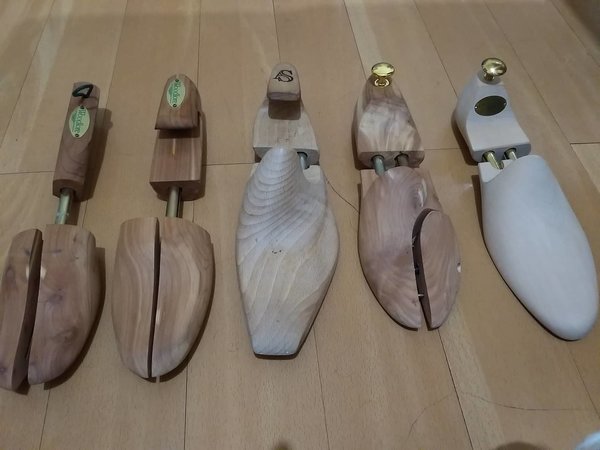ernestgraingergrace
Member
- Joined
- Jun 25, 2019
- Messages
- 20
- Reaction score
- 8
A cautionary tale and a proposal for a more specific way of using of shoe trees...
I have always loved leather shoes, from when I was a small child and my pairs would only cost 50-100USD, to now when my pairs go higher than 1000USD. When I started buying these expensive shoes, I read about shoe trees and made sure to get wooden ones for each pair of shoes I had.
The trees sure kept the shape of my shoes, six years later and the creasing on the outer leather is minimal, certainly better looking than my last pair of Clark's Bostonians. But the insides of these shoes tell a very different story, almost 50% of my pairs have holes or scratches on the lining at the contact points of the wood and the leather. I first noticed lining damage on a pair of JM Westons, I thought this was because the lining was supple (too supple, maybe) and it couldn't take the roughing up of regular wear.
I have been out of the office for almost a year now and my shoes have been stored in their trees all this time, when I did a check this week, almost half of them had holes. The wooden trees probably made the lining too dry and the act of taking out the trees to try on the shoes further scratched and damaged the lining. I took a look at my cheap pair that had no shoe trees and they were fine.
I am very sad about this, now I am thinking that shoes shouldn't be stored for an extended amount of time with shoe trees inside them. Is it better to remove the shoe trees after a day of drying and afterward simply using the crumpled tissue/paper that came with the shoe box?
I also thought cheaper cedar (relatively) shoe trees from Woodlore were to blame. But lasted shoe trees from the shoe manufacturers themselves also damaged some of my pairs. Is it possible that plastic shoe trees may turn out to be better because it doesn't absorb any/excess moisture from the leather and simply maintains the shape of the shoe while it air dries?
In the future, I don't think I will buy anymore shoe trees, it will save me money and I can simply rotate the ones I have now and use them on freshly used shoes and then remove them a day (or even less time) later. It might be a better idea to only have one pair of trees because most men only wear one pair of leather shoes a day.
In the meantime, I have to find a cobbler to repair the lining of my shoes. And does anyone else share the same problem with their pairs?
I have always loved leather shoes, from when I was a small child and my pairs would only cost 50-100USD, to now when my pairs go higher than 1000USD. When I started buying these expensive shoes, I read about shoe trees and made sure to get wooden ones for each pair of shoes I had.
The trees sure kept the shape of my shoes, six years later and the creasing on the outer leather is minimal, certainly better looking than my last pair of Clark's Bostonians. But the insides of these shoes tell a very different story, almost 50% of my pairs have holes or scratches on the lining at the contact points of the wood and the leather. I first noticed lining damage on a pair of JM Westons, I thought this was because the lining was supple (too supple, maybe) and it couldn't take the roughing up of regular wear.
I have been out of the office for almost a year now and my shoes have been stored in their trees all this time, when I did a check this week, almost half of them had holes. The wooden trees probably made the lining too dry and the act of taking out the trees to try on the shoes further scratched and damaged the lining. I took a look at my cheap pair that had no shoe trees and they were fine.
I am very sad about this, now I am thinking that shoes shouldn't be stored for an extended amount of time with shoe trees inside them. Is it better to remove the shoe trees after a day of drying and afterward simply using the crumpled tissue/paper that came with the shoe box?
I also thought cheaper cedar (relatively) shoe trees from Woodlore were to blame. But lasted shoe trees from the shoe manufacturers themselves also damaged some of my pairs. Is it possible that plastic shoe trees may turn out to be better because it doesn't absorb any/excess moisture from the leather and simply maintains the shape of the shoe while it air dries?
In the future, I don't think I will buy anymore shoe trees, it will save me money and I can simply rotate the ones I have now and use them on freshly used shoes and then remove them a day (or even less time) later. It might be a better idea to only have one pair of trees because most men only wear one pair of leather shoes a day.
In the meantime, I have to find a cobbler to repair the lining of my shoes. And does anyone else share the same problem with their pairs?


